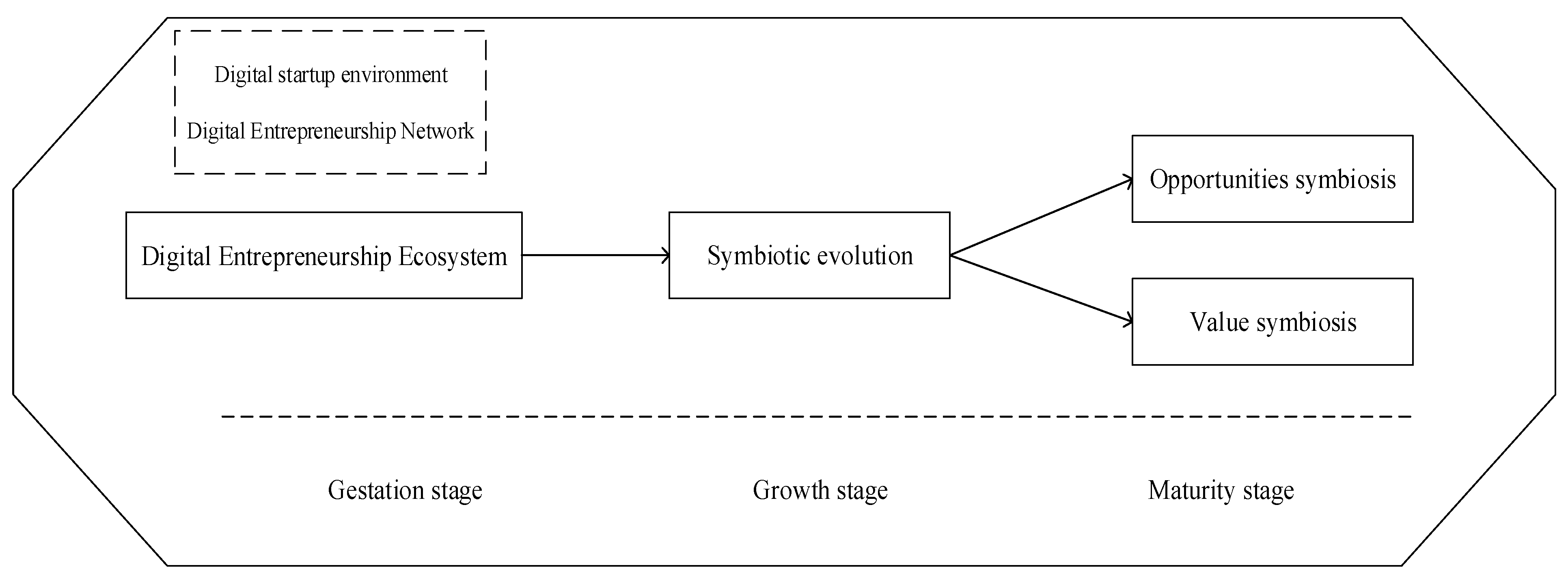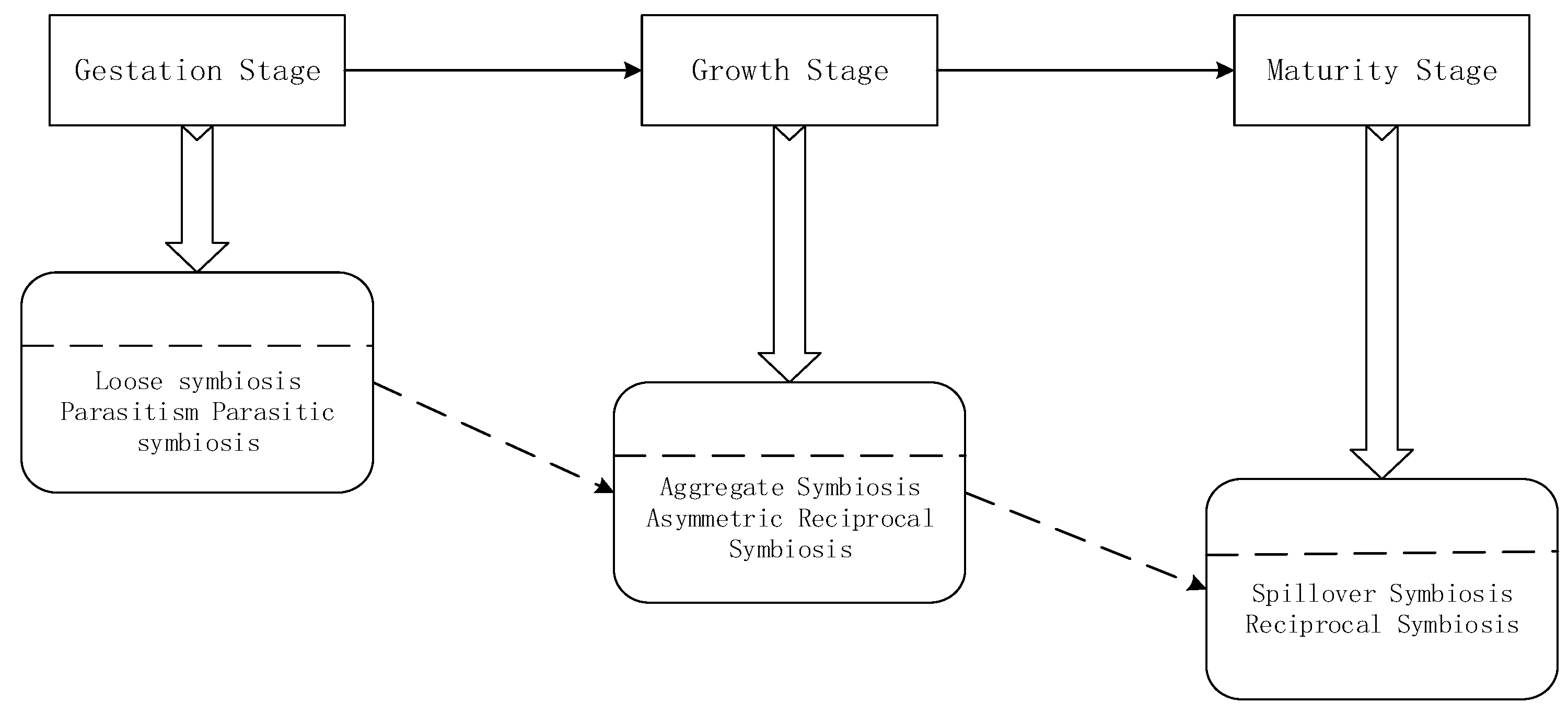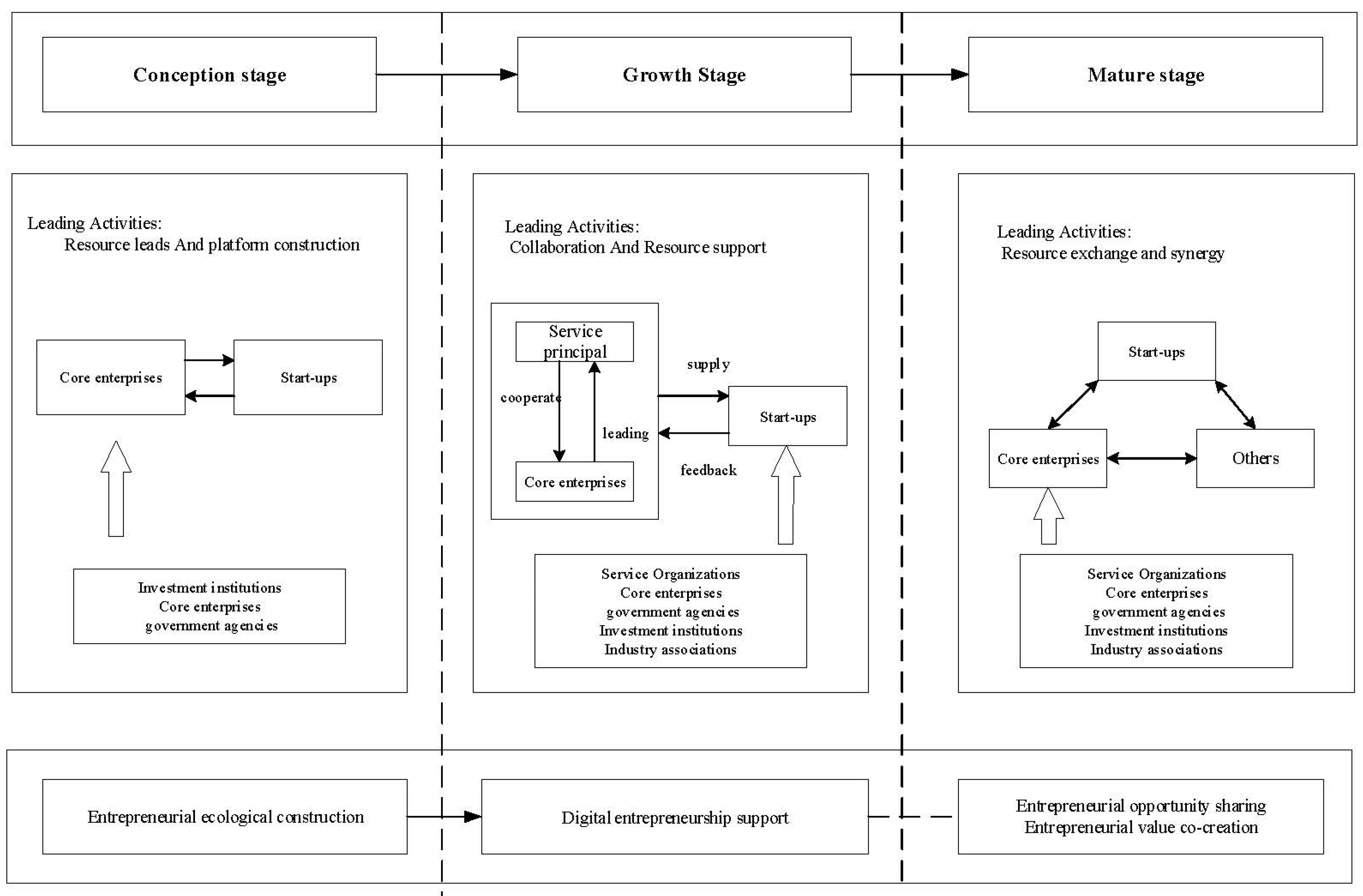The Composition and Operation Mechanism of Digital Entrepreneurial Ecosystem: A Study of Hangzhou Yunqi Town as an Example
Abstract
1. Introduction
2. Literature Review
2.1. The Connotation and Composition of the DEE
2.2. Research Schools of Thought on the DEE
2.3. Composition and Synergistic Symbiosis of Digital Subjects
2.4. Evolutionary Stages of the DEE
2.4.1. Evolution of Digital Entrepreneurship Network
2.4.2. The Evolution of the Digital Entrepreneurial Environment
2.5. The Theoretical Framework of the Evolution Mechanism of the DEE
3. Methodology
3.1. Research Case Selection
- (1)
- Uniqueness of the case. Dream Town is a DEE created by Hangzhou City based on the industrial ecology of Alibaba’s headquarters and financial resources, through the creation of a “crowdsourcing space”, “gas pedal”, and “O2O service system”. Dream Town is a digital entrepreneurship ecosystem based on Alibaba’s headquarters and financial resources. Alibaba’s cloud ecology is at the core of the town’s ecosystem, around which digital subjects build their ecological chains. Secondly, the Alibaba-led innovation network was built only after it settled in Dream Town, which makes this case conducive to studying the whole process of digital entrepreneurship ecosystem evolution. Finally, Dream Town is a well-developed digital entrepreneurship town, and the pulling effect of the town on regional economic and social development is highly recognized by the government and society.
- (2)
- The operability of the research. Eight years after its inception in 2015, Dream Town’s development process is extremely complete, with significant differences in each stage, which can provide relevant material for this study. In addition, the dynamic development process of Hangzhou Dream Town can be analyzed to conclude with certain universality. This will provide a reference for the practical and theoretical investigation of digital entrepreneurship ecosystems.
- (3)
- Availability of data. The research team once lived in Hangzhou, and colleagues were able to talk to the relevant responsible persons and start-up entrepreneurs in the Dream Town, which was convenient for obtaining first-hand interview data. Moreover, as a leading enterprise in Internet entrepreneurship, Alibaba has produced much attention and has formed a series of achievements and reports. Therefore, it is easier to obtain relevant data.
3.2. Research Data Collection
4. Hangzhou Dream Town Case Description
Background of the Case
5. Analysis of the Development Stage of the DEE in Dream Town
5.1. Gestation Stage: Builder-Led and Ecosystem Initiation
5.2. Growth Stage: Herd Effect and Multi-Subject Synergy
5.3. Mature Stage: Ecological Stability and Multi-Subject Symbiosis
6. The Dynamic Evolution Mechanism of DEE
- (1)
- The main characteristics of the DEE at different stages.
- (2)
- The expressions of value symbiosis and opportunity symbiosis in DEE at different stages.
- (3)
- The evolution of digital entrepreneurship models, environments, and networks.
6.1. Opportunity Symbiosis and Value Symbiosis
6.2. Digital Entrepreneurship Network
6.3. Digital Entrepreneurial Environment
7. Discussion
8. Conclusions
8.1. Theoretical and Practical Implications
8.2. Limitations and Future Research
Author Contributions
Funding
Institutional Review Board Statement
Informed Consent Statement
Conflicts of Interest
References
- Kraus, S.; Palmer, C.; Kailer, N.; Kallinger, F.L.; Spitzer, J. Digital entrepreneurship: A research agenda on new business models for the twenty-first century. Int. J. Entrep. Behav. Res. 2018, 25, 353–375. [Google Scholar] [CrossRef]
- Nambisan, S. Digital entrepreneurship: Toward a digital technology perspective of entrepreneurship. Entrep. Theory Pract. 2017, 41, 1029–1055. [Google Scholar] [CrossRef]
- Bharadwaj, A.; El Sawy, O.A.; Pavlou, P.A.; Venkatraman, N.V. Digital business strategy: Toward the next generation of insights. MIS Q. 2013, 37, 471–482. [Google Scholar] [CrossRef]
- Sussan, F.; Acs, Z.J. The digital entrepreneurial ecosystem. Small Bus. Econ. 2017, 49, 55–73. [Google Scholar] [CrossRef]
- Li, W.; Du, W.; Yin, J.M. Digital entrepreneurship ecosystem as a new form of organizing: The case of Zhongguancun. Front. Bus. Res. China 2017, 11, 5. [Google Scholar] [CrossRef]
- Acs, Z.J.; Autio, E.; Szerb, L. National systems of entrepreneurship: Measurement issues and policy implications. Res. Policy 2014, 43, 476–494. [Google Scholar] [CrossRef]
- Thompson, T.A.; Purdy, J.M.; Ventresca, M.J. How entrepreneurial ecosystems take form: Evidence from social impact initiatives in Seattle. Strateg. Entrep. J. 2018, 12, 96–116. [Google Scholar] [CrossRef]
- Sahut, J.M.; Iandoli, L.; Teulon, F. The age of digital entrepreneurship. Small Bus. Econ. 2021, 56, 1159–1169. [Google Scholar] [CrossRef]
- Wurth, B.; Stam, E.; Spigel, B. Toward an entrepreneurial ecosystem research program. Entrep. Theory Pract. 2022, 46, 729–778. [Google Scholar] [CrossRef]
- Malecki, E.J. Entrepreneurship and entrepreneurial ecosystems. Geogr. Compass 2018, 12, e12359. [Google Scholar] [CrossRef]
- Spigel, B. The relational organization of entrepreneurship ecosystems. Entrep. Theory Pract. 2017, 41, 49–72. [Google Scholar] [CrossRef]
- Cunningham, J.A.; Menter, M.; Wirsching, K. Entrepreneurial ecosystem governance: A principal investigator-centered governance framework. Small Bus. Econ. 2019, 52, 545–562. [Google Scholar] [CrossRef]
- Spigel, B.; Harrison, R. Toward a process theory of entrepreneurial ecosystems. Strateg. Entrep. J. 2018, 12, 151–168. [Google Scholar] [CrossRef]
- De Brito, S.; Leitão, J. Mapping and defining entrepreneurial ecosystems: A systematic literature review. Knowl. Manag. Res. Pract. 2021, 19, 21–42. [Google Scholar] [CrossRef]
- Wachira, E.W. Analysis of Austria’s Entrepreneurial Ecosystem Based on the Gei Approach. Int. J. Entrep. Knowl. 2022, 10, 123–136. [Google Scholar] [CrossRef]
- Bichler, B.F.; Kallmuenzer, A.; Peters, M.; Petry, T.; Clauss, T. Regional entrepreneurial ecosystems: How family firm embeddedness triggers ecosystem development. Rev. Manag. Sci. 2022, 16, 15–44. [Google Scholar] [CrossRef]
- Suresh, J.; Ramraj, J. Entrepreneurial Ecosystem: Case Study on the Influence of Environmental Factors on Entrepreneurial Success. Eur. J. Bus. Manag. 2012, 14, 95–101. [Google Scholar]
- Cohen, B. Sustainable valley entrepreneurial ecosystems. Bus. Strategy Environ. 2006, 15, 1–14. [Google Scholar] [CrossRef]
- Dini, P.; Qian, M.; Mansell, R. The possibility of Interdisciplinarity: Lessons from Constructing a Theoretical Framework for Digital Ecosystems. Cult. Theory Crit. 2011, 52, 3–27. [Google Scholar] [CrossRef]
- Weill, P.; Woerner, S.L. Thriving in an increasingly digital ecosystem. MIT Sloan Manag. Rev. 2015, 56, 27. [Google Scholar]
- Elia, G.; Margherita, A.; Passiante, G. Digital entrepreneurship ecosystem: How digital technologies and collective intelligence are reshaping the entrepreneurial process. Technol. Forecast. Soc. Chang. 2020, 150, 119791. [Google Scholar] [CrossRef]
- Von Briel, F.; Davidsson, P.; Recker, J. Digital technologies as external enablers of new venture creation in the IT hardware sector. Entrep. Theory Pract. 2018, 42, 47–69. [Google Scholar] [CrossRef]
- Lyytinen, K.; Yoo, Y.; Boland, R.J., Jr. Digital product innovation within four classes of innovation networks. Inf. Syst. J. 2016, 26, 47–75. [Google Scholar] [CrossRef]
- Tiwana, A.; Konsynski, B.; Bush, A.A. Platform evolution: Coevolution of platform architecture, governance, and environmental dynamics. Inf. Syst. Res. 2010, 21, 675–687. [Google Scholar] [CrossRef]
- Aldrich, H.E. The democratization of entrepreneurship? Hackers, maker spaces, and crowdfunding. In Proceedings of the Annual Meeting of the Academy of Management, Philadelphia, PA, USA, 4 August 2014; Volume 10, pp. 1–7. [Google Scholar]
- Kuester, S.; Konya-Baumbach, E.; Schuhmacher, M.C. Get the show on the road: Go-to-market strategies for e-innovations of start-ups. J. Bus. Res. 2018, 83, 65–81. [Google Scholar] [CrossRef]
- Rippa, P.; Secundo, G. Digital academic entrepreneurship: The potential of digital technologies on academic entrepreneurship. Technol. Forecast. Soc. Chang. 2019, 146, 900–911. [Google Scholar] [CrossRef]
- Kuebart, A. Geographies of relational coordination in venture capital firms. Eur. Plan. Stud. 2019, 27, 2206–2226. [Google Scholar] [CrossRef]
- Gawer, A.; Cusumano, M.A. Industry platforms and ecosystem innovation. J. Prod. Innov. Manag. 2014, 31, 417–433. [Google Scholar] [CrossRef]
- Nambisan, S.; Siegel, D.; Kenney, M. On open innovation, platforms, and entrepreneurship. Strateg. Entrep. J. 2018, 12, 354–368. [Google Scholar] [CrossRef]
- Jacobides, M.G.; Cennamo, C.; Gawer, A. Towards a theory of ecosystems. Strateg. Manag. J. 2018, 39, 2255–2276. [Google Scholar] [CrossRef]
- Elia, G.; Margherita, A.; Petti, C. An operational model to develop technology entrepreneurship “EGO-System”. Int. J. Innov. Technol. Manag. 2016, 13, 1640008. [Google Scholar] [CrossRef]
- Ahmetoglu, G.; Chamorro-Premuzic, T.; Klinger, B.; Karcisky, T. (Eds.) The Wiley Handbook of Entrepreneurship; John Wiley and Sons: New York, NY, USA, 2017. [Google Scholar]
- Torres, P.; Godinho, P. Levels of necessity of entrepreneurial ecosystems elements. Small Bus. Econ. 2022, 59, 29–45. [Google Scholar] [CrossRef]
- Muegge, S.M.; Mezen, M. Business ecosystems and new venture business models: An exploratory study of participation in the Lead to Win job-creation engine. Int. J. Technol. Manag. 2017, 78, 157–192. [Google Scholar] [CrossRef]
- Cennamo, C.; Santalo, J. Platform competition: Strategic trade-offs in platform markets. Strateg. Manag. J. 2013, 34, 1331–1350. [Google Scholar] [CrossRef]
- Gawer, A. Bridging differing perspectives on technological platforms: Toward an integrative framework. Res. Policy 2014, 43, 1239–1249. [Google Scholar] [CrossRef]
- Eckhardt, J.T.; Ciuchta, M.P.; Carpenter, M. Open innovation, information, and entrepreneurship within platform ecosystems. Strateg. Entrep. J. 2018, 12, 369–391. [Google Scholar] [CrossRef]
- Zhu, F.; Liu, Q. Competing with complementors: An empirical look at Amazon. Com. Strateg. Manag. J. 2018, 39, 2618–2642. [Google Scholar] [CrossRef]
- Zahra, S.A.; Nambisan, S. Entrepreneurship and strategic thinking in business ecosystems. Bus. Horiz. 2012, 55, 219–229. [Google Scholar] [CrossRef]
- Gómez-Uranga, M.; Miguel, J.C.; Zabala-Iturriagagoitia, J.M. Epigenetic economic dynamics: The evolution of big internet business ecosystems, evidence for patents. Technovation 2014, 34, 177–189. [Google Scholar] [CrossRef]
- Zhu, X.M.; Yang, S. A review and outlook of research on digital entrepreneurship ecosystem. Foreign Econ. Manag. 2022, 44, 48–63. [Google Scholar]
- Zhu, X.M.; Lin, X.Y.; Wang, T. Dynamic evolution mechanism of digital entrepreneurship ecosystem: A case study based on Hangzhou Yunqi town. J. Manag. 2020, 17, 487–497. [Google Scholar]
- Chertow, M.; Ehrenfeld, J. Organizing self-organizing systems: Toward a theory of industrial symbiosis. J. Ind. Ecol. 2012, 16, 13–27. [Google Scholar] [CrossRef]
- Autio, E.; Nambisan, S.; Thomas, L.D.; Wright, M. Digital affordances, spatial affordances, and the genesis of entrepreneurial ecosystems. Strateg. Entrep. J. 2018, 12, 72–95. [Google Scholar] [CrossRef]
- Srinivasan, A.; Venkatraman, N. Entrepreneurship in digital platforms: A network-centric view. Strateg. Entrep. J. 2018, 12, 54–71. [Google Scholar] [CrossRef]
- Mack, E.; Mayer, H. The evolutionary dynamics of entrepreneurial ecosystems. Urban Stud. 2016, 53, 2118–2133. [Google Scholar] [CrossRef]
- Stam, F.C.; Spigel, B. Entrepreneurial ecosystems. USE Discuss. Pap. Ser. 2016, 16, 301–325. [Google Scholar]
- Bai, F. A study of entrepreneurial ecosystem based on life cycle theory perspective. Mod. Manag. Sci. 2015, 34, 52–54. [Google Scholar]
- Zhu, X.M.; Li, M.F. The dynamic influence of entrepreneurial network characteristics on resource access: Evidence based on China’s transition economy. Manag. World 2011, 26, 105–115. [Google Scholar]
- Allen, T.J.; Gloor, P.; Colladon, A.F.; Woerner, S.L.; Raz, O. The power of reciprocal knowledge sharing relationships for startup success. J. Small Bus. Enterp. Dev. 2016, 23, 636–651. [Google Scholar] [CrossRef]
- Fagerberg, J.; Mowery, D.C.; Nelson, R.R. The Oxford Handbook of Innovation; Oxford University Press: Oxford, UK, 2005; pp. 291–317. [Google Scholar]
- Sassen, S. Economic restructuring and the American city. Annu. Rev. Sociol. 1990, 16, 465–490. [Google Scholar] [CrossRef]
- Bernardez, M.; Mead, M. The power of entrepreneurial ecosystems: Extracting boom from bust. PII Rev. 2009, 2, 12–45. [Google Scholar]
- Tedeschi, G.; Iori, G.; Gallegati, M. Herding effects in order driven markets: The rise and fall of gurus. J. Econ. Behav. Organ. 2012, 81, 82–96. [Google Scholar] [CrossRef]
- Chen, C.; Li, Z.; Chao, L.; Shi, X. The Synergetic and Symbiosis Theory: A New Management Paradigm in the Digital Age. Foreign Econ. Manag. 2022, 44, 68–83. [Google Scholar]
- Orton, J.D.; Weick, K.E. Loosely coupled systems: A reconceptualization. Acad. Manag. Rev. 1990, 15, 203–223. [Google Scholar] [CrossRef]
- Clarysse, B.; Wright, M.; Bruneel, J.; Mahajan, A. Creating value in ecosystems: Crossing the chasm between knowledge and business ecosystems. Res. Policy 2014, 43, 1164–1176. [Google Scholar] [CrossRef]
- Alvarez, S.A.; Young, S.L.; Woolley, J.L. Opportunities and institutions: A co-creation story of the king crab industry. J. Bus. Ventur. 2015, 30, 95–112. [Google Scholar] [CrossRef]
- Le Breton-Miller, I.; Miller, D. Agency vs. stewardship in public family firms: A social embeddedness reconciliation. Entrep. Theory Pract. 2009, 33, 1169–1191. [Google Scholar] [CrossRef]
- Ritter, T. The networking company: Antecedents for coping with relationships and networks effectively. Ind. Mark. Manag. 1999, 28, 467–479. [Google Scholar] [CrossRef]
- Overholm, H. Collectively created opportunities in emerging ecosystems: The case of solar service ventures. Technovation 2015, 39, 14–25. [Google Scholar] [CrossRef]
- De Vasconcelos Gomes, L.A.; Facin, A.L.F.; Salerno, M.S.; Ikenami, R.K. Unpacking the innovation ecosystem construct Evolution, gaps, and trends. Technol. Forecast. Soc. Chang. 2018, 136, 30–48. [Google Scholar] [CrossRef]
- Odum, H.T. Self-organization, transformity, and information. Science 1988, 242, 1132–1139. [Google Scholar] [CrossRef] [PubMed]
- Zahra, S.A.; Nambisan, S. Entrepreneurship in global innovation ecosystems. AMS Rev. 2011, 1, 4–17. [Google Scholar] [CrossRef]
- Brown, R.; Mason, C. Looking inside the spiky bits: A critical review and conceptualisation of entrepreneurial ecosystems. Small Bus. Econ. 2017, 49, 11–30. [Google Scholar] [CrossRef]
- Meynhardt, T.; Chandler, J.D.; Strathoff, P. Systemic principles of value co-creation: Synergetics of value and service ecosystems. J. Bus. Res. 2016, 69, 2981–2989. [Google Scholar] [CrossRef]
- Suddaby, R.; Bruton, G.D.; Si, S.X. Entrepreneurship through a qualitative lens: Insights on the construction and/or discovery of entrepreneurial opportunity. J. Bus. Ventur. 2015, 30, 1–10. [Google Scholar] [CrossRef]
- Meyskens, M.; Carsrud, A.L.; Cardozo, R.N. The symbiosis of entities in the social engagement network: The role of social ventures. Entrep. Reg. Dev. 2010, 22, 425–455. [Google Scholar] [CrossRef]
- Slotte-Kock, S.; Coviello, N. Entrepreneurship research on network processes: A review and ways forward. Entrep. Theory Pract. 2010, 34, 31–57. [Google Scholar] [CrossRef]
- Vandekerckhove, W.; Dentchev, N.A. A network perspective on stakeholder management: Facilitating entrepreneurs in the discovery of opportunities. J. Bus. Ethics 2005, 60, 221–232. [Google Scholar] [CrossRef]
- McKeever, E.; Jack, S.; Anderson, A. Embedded entrepreneurship in the creative re-construction of place. J. Bus. Ventur. 2015, 30, 50–65. [Google Scholar] [CrossRef]
- Dyer, J.H.; Gregersen, H.B.; Christensen, C. Entrepreneur behaviors, opportunity recognition, and the origins of innovative ventures. Strateg. Entrep. J. 2008, 2, 317–338. [Google Scholar] [CrossRef]
- McKelvey, M.; Zaring, O.; Ljungberg, D. Creating innovative opportunities through research collaboration: An evolutionary framework and empirical illustration in engineering. Technovation 2015, 39, 26–36. [Google Scholar] [CrossRef]
- Maillat, D. Territorial dynamic, innovative milieus and regional policy. Entrep. Reg. Dev. 1995, 7, 157–165. [Google Scholar] [CrossRef]
- Karlsson, C.; Andersson, M. The location of industry R&D and the location of university R&D: How are they related. In New Directions in Regional Economic Development; Springer: Berlin/Heidelberg, Germany, 2009; pp. 267–290. [Google Scholar]
- Goldstein, H.; Drucker, J. The economic development impacts of universities on regions: Do size and distance matter? Econ. Dev. Q. 2006, 20, 22–43. [Google Scholar] [CrossRef]
- Sambamurthy, V.; Bharadwaj, A.; Grover, V. Shaping agility through digital options: Reconceptualizing the role of information technology in contemporary firms. MIS Q. 2003, 27, 237–263. [Google Scholar] [CrossRef]
- Yoo, Y.; Henfridsson, O.; Lyytinen, K. Research commentary—The new organizing logic of digital innovation: An agenda for information systems research. Inf. Syst. Res. 2010, 21, 724–735. [Google Scholar] [CrossRef]
- Aminova, M.; Mareef, S.; Machado, C. Entrepreneurship Ecosystem in Arab World: The status quo, impediments and the ways forward. Int. J. Bus. Ethics Gov. 2020, 3, 1–13. [Google Scholar] [CrossRef]
- Du, W.; Pan, S.L.; Zhou, N.; Ouyang, T. From a marketplace of electronics to a digital entrepreneurial ecosystem (DEE): The emergence of a meta-organization in Zhongguancun, China. Inf. Syst. J. 2018, 28, 1158–1175. [Google Scholar] [CrossRef]
- Engel, J.S.; Del-Palacio, I. Global clusters of innovation: The case of Israel and Silicon Valley. Calif. Manag. Rev. 2011, 53, 27–49. [Google Scholar] [CrossRef]






| Research Perspectives | Author (Year) | Composition | |
|---|---|---|---|
| Entrepreneurial Subjects | Entrepreneurial Elements | ||
| Entrepreneurial Ecosystem | Wachira (2022) [15] | Government, clients, investment institutions, educational institutions, public institutions, professional institutions | The system, natural environment, market, policy, infrastructure |
| Bichler (2022) [16] | Government, science and technology parks, universities, social networks, investment institutions, support services, technology companies, etc. | Policy, funding, market, human capital, culture, supportive environment | |
| Suresh and Ramraj (2012) [17] | Investment institutions, government, intermediaries, social networks, etc. | Ethical, financial, technological, market, financial, social, network, policy, environmental systems | |
| Cohen (2006) [18] | Startups, large enterprises providing technical support, governments, universities, research institutions, investment institutions, intermediaries | Policy preference, talent supply, financial support, professional consultation, basic setup, social norms, geographical location | |
| Digital Ecosystem | Nambisan (2017) [2] | Digital infrastructure, digital users, digital startups | Digital Technology and Digital Markets |
| Dini et al. (2011) [19] | Digital technology, digital users | Digital Environment | |
| Weill and Woerner (2015) [20] | Digital users, government, research institutions, investment institutions | Digital technology, digital environment, digital culture | |
| Composition and Function of the Digital Subject | |
|---|---|
| Elements | Function |
| Digital Startups |
|
| Digital Users |
|
| Government |
|
| Universities, Research Institutes |
|
| Investment Institutions |
|
| Entrepreneurial Service Provider |
|
| Digital Incubator |
|
Publisher’s Note: MDPI stays neutral with regard to jurisdictional claims in published maps and institutional affiliations. |
© 2022 by the authors. Licensee MDPI, Basel, Switzerland. This article is an open access article distributed under the terms and conditions of the Creative Commons Attribution (CC BY) license (https://creativecommons.org/licenses/by/4.0/).
Share and Cite
Chu, J.; Li, J. The Composition and Operation Mechanism of Digital Entrepreneurial Ecosystem: A Study of Hangzhou Yunqi Town as an Example. Sustainability 2022, 14, 16607. https://doi.org/10.3390/su142416607
Chu J, Li J. The Composition and Operation Mechanism of Digital Entrepreneurial Ecosystem: A Study of Hangzhou Yunqi Town as an Example. Sustainability. 2022; 14(24):16607. https://doi.org/10.3390/su142416607
Chicago/Turabian StyleChu, Jiewang, and Jiaxuan Li. 2022. "The Composition and Operation Mechanism of Digital Entrepreneurial Ecosystem: A Study of Hangzhou Yunqi Town as an Example" Sustainability 14, no. 24: 16607. https://doi.org/10.3390/su142416607
APA StyleChu, J., & Li, J. (2022). The Composition and Operation Mechanism of Digital Entrepreneurial Ecosystem: A Study of Hangzhou Yunqi Town as an Example. Sustainability, 14(24), 16607. https://doi.org/10.3390/su142416607





